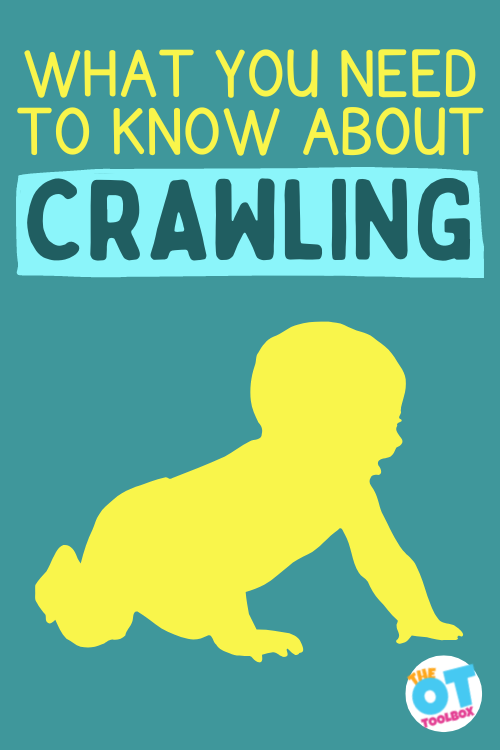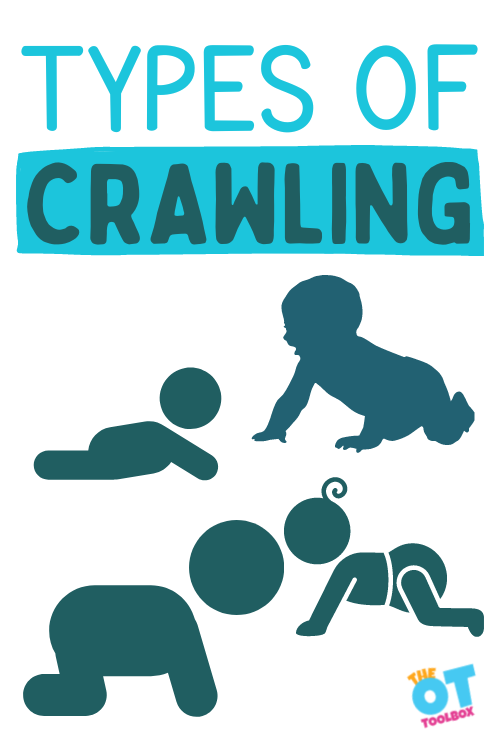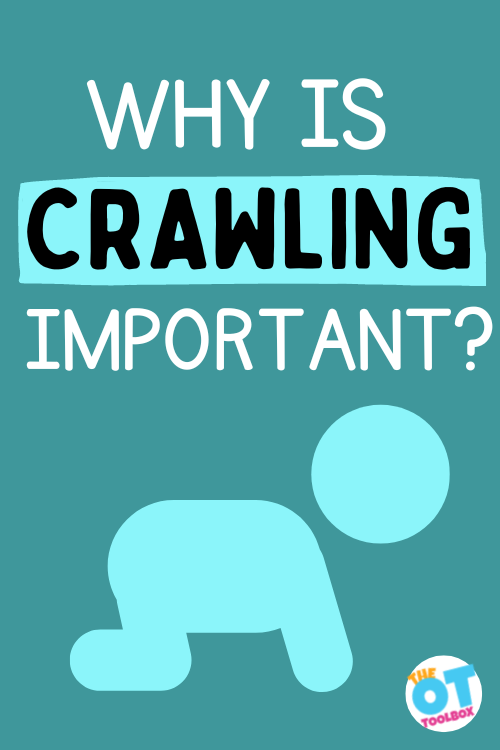Crawling is a babies’ first move toward independence, but did you know there are different types of crawling a baby can use? In this post we will explore: when babies start to crawl, types of crawling (army crawl, cross crawl, bear crawl, asymmetrical crawling), why crawling is important, and how to teach crawling. Crawling is not just a gross motor activity. Crawling is a motor task component baby play that activates several of the senses, is a social event, and is the beginning of functional play.

WHEN DO BABIES START TO CRAWL?
Babies start to crawl between six and ten months, however with the various types of crawling, there are things to know about skills that impact a baby’s ability to move from place to place.
Some skip crawling all together, moving straight to cruising furniture and walking. We will explore later why skipping crawling is not a great idea.
In order to crawl, babies need a few skills, developmentally. This progression to crawling is a sequence of events.
Before crawling, babies learn to:
- Roll over
- Push up on their arms during tummy time
- Rock back and forth on their knees,
- Push backward
When given plenty of opportunity for movement, this stage of development often happens naturally. Crawling gives the baby an excellent sense of power and accomplishment. It is a huge boost to their self esteem.
There are several systems at play for these skills and crawling as a result to occur. The underlying skills involved with crawling includes:
- Cognition
- Problem solving
- Balance (motor skills)
- Sensory system
- Gross motor skills
- Coordination
- Visual Motor skills
- Spatial Relations
Referring specifically to the motor skills needed to crawl, we can target gross motor coordination and balance, no matter what type of crawling or mobility that a baby is using. The crawling movements utilize strength, mobility, and stabilization of the muscles of shoulders, neck, arms, back, trunk, and head need to be strong enough to support the weight of the baby.
Binocular vision is needed for babies to switch between distance and close up viewing as they navigate their space. Crawling offers a great mental workout as well.

Types of Crawling
Did you know there are different types of crawling? Some of these types of crawling styles are a progression in coordination and balance. The baby will begin with one type of crawling and move onto a different crawling style, developmentally.
Other types of baby crawls are the style that the baby adopts either because one of the underlying skills have not yet developed, or they get into a habit and realize that they can get from A to B efficiently using the particular style. The different ways babies crawl do not necessarily mean a problem. However, there are aspects of each type of baby crawling style which we can look at.
Let’s take a closer look at each style of crawl.
Crawling on Hands and Knees
Crawling on hands and knees, or the classic hands and knees crawling style is a form of cross crawl – in therapy language this is often referred to as creeping. Babies bear weight on their hands and knees, moving one arm with the opposite knee forward at the same time. This is the classic, traditional, most beneficial type of developmental crawling.
Bear crawl
Related to the classic crawling style on hands and knees, is the bear crawl. The bear crawl style of crawling is one in which babies cruise around on their hands and feet with their bottom up in the air. This type of crawl provides great proprioceptive input, as well as reciprocal movement.
Army Crawl or Commando crawl
The army crawl, or otherwise known as the commando crawl, is a belly crawl style of crawling. This military style crawl involves babies on their tummies pulling themselves along with their arms and elbows while their stomach drags on the floor. This type of crawl is excellent for building upper body strength, as well as providing great sensory input.
Scoot Crawling
The bottom scoot crawl, or scoot crawling is another style of crawling. In this type of crawl, babies sit on their bottom, pulling themselves with their arms. While this is a functional type of movement, it is not the most efficient or beneficial. While scooting on their bottom, babies do not get the same reciprocal type of movement, or input through their legs and shoulder girdle.
Crab crawl
Crab crawl is a crawling style in which babies move themselves backward or sideways in this type of crawling movement pattern. They might be prone (belly down) or supine (belly up) as they move. This might be a functional movement style, but it is not providing the correct input and movement patterns for typical development.
Roll crawl
A roll crawl is another type of crawling which works as a mode of transportation for babies. With roll crawling, babies get where they want to go by rolling. This style of crawling is effective, in that the child gets to where they want in a room, however rolling crawl is not an efficient style of movement, nor is it a means of developing the best movement patterns.
Have you seen any of these types of crawling in action? Let’s move onto why crawling skills are an important part of development for young children.

Why is crawling important
There are many reasons why babies need to crawl as a developmental progression. Crawling is so important! Let’s take a look at each of the reasons why babies need to crawl.
- Gross motor development – babies learn to coordinate both sides of their body as they crawl. They have to balance their body, while an arm and leg is off of the ground at the same time. Joints need to flex and extend, muscles must synchronize, all while each side of the body is doing a completely different movement.
- Eye-hand coordination- By crawling, babies develop eye-hand coordination. By moving toward a target, reaching for toys, and engaging in the world around them, coordination between the eyes and body develop.
- Sensory development – proprioception, or input/feedback through the muscles and joints is the primary input developed through crawling. In addition, vestibular input is engaged through movement of the head and input through the ear. Vision, tactile, and hearing senses are activated as well during crawling. Babies learn through exploring their environment. During crawling, most of the senses are alerted, organized, and used to maneuver through space.
- Mental/cognitive development – problem solving, memory, and processing information are needed for crawling. The corpus callosum is activated in a balanced way during cross crawling, facilitating both sides of the brain to communicate. The corpus callosum is not activated the same way during alternate methods of crawling (bottom scooting, crab crawl, commando crawl).
- Crawling helps joint sockets form – as the baby crawls forward the hip sockets form, the muscles pulling them forward and inward. This sets the development in motion for future walking.
- Crossing midline – this is a vital skill for further development. Cross crawling improves spinal rotation, eye hand coordination, and learning to separate both sides of the body which will be used later on (bike riding, playing the piano, running, climbing stairs). Here are some cross crawl exercises for older learners to practice and develop this critical skill.
- Crawling supports reading skills- Crawling on hands and knees helps reading! All this integration of brain halves, reflexes, and hand-eye coordination helps prepare the brain and body for reading. Crawling supports learning, creative problem solving, and brain function in general.
- Visual Skills- When crawling, a baby is developing the building blocks of visual perception, visual tracking and visual scanning, as well as vision development When crawling a small child moves through space and the eyes develop visual convergence. Visual saccades and tracking is also a component of development. Read more about the development of visual spatial skills happening during the baby years.
NOTE: babies who crawl in alternate methods, while demonstrating creative ways of getting around, may be showing signs of delayed development. They may have learned to compensate for poor strength, coordination, sensory skills, or cognitive development. Moving babies through the traditional methods of crawling can help with overall development. Babies who skip crawling should be encouraged to move through this stage of development, as it will develop critical baseline skills to be used later on.
How to teach Crawling
The easiest way to encourage crawling is by setting up an optimal environment for exploration.
- Plenty of tummy time on a safe surface may be all that is needed for these skills to develop. Some families do not have a safe space at home for crawling. Get creative by suggesting a blanket on the grass, an open space such as the beach, the library floor, or a tarp on the ground covered by a blanket.
- Avoid propping the baby up and placing it in containers. Container baby syndrome is increasing at an alarming rate as caregivers place young babies continually in car seats, carriers, bouncy seats, swings, or being held all of the time.
- If your baby arches her back a lot, does not want to curl up and snuggle, does not use both arms and legs, uses rolling more often than crawling, or does not seem interested in moving, seek assistance from a functional neurology doctor.
- Allow your baby to explore their environment freely. Create safe zones free of wires, choking hazards, and other dangers. Encourage caregivers not to be afraid to let their baby struggle. Caregivers need to understand that babies will topple over several times before getting it right. A baby who is too sheltered will learn that movement is scary.
- Hold a rolled up towel under your babies’ belly while they are in prone to relieve some of the weight off of their extremities, provide extra support, and move the baby through the crawling motions.
- Help the baby get into a crawling position and gently rock them back and forth to stimulate movement. Place items just out of reach of the baby to encourage them to reach for it, or move to try and get it.
- Encourage movement toward a target using novel and innovative items such as these baby shaker toys or our engaging sensory baggie for babies.
Help parents and caregivers understand misconceptions that a baby isn’t “advanced” who skips crawling, “so cute” by bottom scooting instead of cross crawling, or “lazy” because they choose not to move. While these aren’t always red flags for future difficulties, they can be, and should not be overlooked.

Victoria Wood, OTR/L is a contributor to The OT Toolbox and has been providing Occupational Therapy treatment in pediatrics for more than 25 years. She has practiced in hospital settings (inpatient, outpatient, NICU, PICU), school systems, and outpatient clinics in several states. She has treated hundreds of children with various sensory processing dysfunction in the areas of behavior, gross/fine motor skills, social skills and self-care. Ms. Wood has also been a featured speaker at seminars, webinars, and school staff development training. She is the author of Seeing your Home and Community with Sensory Eyes.






